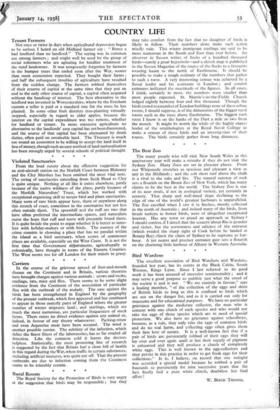Rural Roosts
The Royal Society for the Protection of Birds is very angry at the suggestion that birds may be responsible ; but they
may take comfort from the fact that no slaughter of birds is likely to follow. Their numbers alone make such action wholly vain. This winter immigrant starlings are said to be more numerous in the South and East than ever before. An observer in Sussex writes of flocks of a hundred thousand birds—surely a great hyperbole—and a sketch map is published in the Sussex Magazine of the routes of the flocks to a favourite roosting haunt to the north of Eastbourne. It should be possible to make a rough estimate of the numbers that gather to such a roost. A very interesting census was achieved by a Scout leader and his assistants in London ; and control estimates indicated the exactitude of the figures. In all cases, I think, certainly in most, the numbers were smaller than most people expected. St. Martin's-in-the-Fields Church lodged nightly between four and five thousand. Though the birds crowd to a number of London buildings none of these urban roosts, I should suppose, is of the dimensions of the bigger rural roosts such as the trees above Eastbourne. The biggest rook roost I know is on the banks of the Dart a mile or two from the mouth. It might be worth the while of the highly expert leader of the ornithologists at the Royal Naval College to make a census of these birds and an investigation of their routes. The birds certainly gather from long distances.






































 Previous page
Previous page